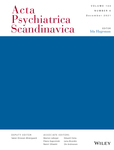Relation Between Brain Morphological Features and Psychiatric Hospitalization Risk in Major Depressive and Bipolar Disorders
Abstract
Introduction
Patients with mood disorders, especially, major depressive disorder (MDD) and bipolar disorder (BD), are at heightened risk of relapse and psychiatric rehospitalizations. Therefore, there is an urgent need to identify modifiable biomarkers to inform personalized and intensified prevention strategies for those at the greatest risk of relapse and hospital readmissions. Brain structural measures subserving cognitive function hold particular promise among potential predictive biomarkers.
Methods
In the present study, structural magnetic resonance imaging scans were obtained from 319 patients with BD (n = 241) or MDD (n = 78). [Correction added on 7 March 2025, after first online publication: In the preceding sentence, ‘MDD (n=241) or BD (n=78)’ has been changed to ‘BD (n=241) or MDD (n=78)’.] Longitudinal data on psychiatric hospitalization for up to 10 years were available from the Danish National population-based registers. Interhemispheric hippocampal asymmetry, a putative marker of cognitive function and brain reserve, was calculated for each patient. The association between hippocampal asymmetry and future psychiatric hospitalization was assessed using a cause-specific Cox regression model. Exploratory analyses, also using a cause-specific Cox model, assessed the association of prefrontal and hippocampal gray matter volume and whole-brain white matter volume with hospitalizations.
Results
The results indicated a negative association between rightward hippocampal asymmetry (i.e., left<right) and risk of future hospitalizations (HR = 0.90, corresponding to a 10-year risk reduction of 0.018 for a 1% increase in asymmetry, p = 0.040). Exploratory analysis indicated that a larger right hippocampus volume was associated with a reduced risk of hospitalization (HR = 0.18, p = 0.004) while a larger bilateral dorsolateral prefrontal volume (HR = 1.06, p = 0.01) was associated with an increased risk of hospitalization.
Conclusion
The findings suggest a role for hippocampal and, additionally, prefrontal morphological features in the risk of future psychiatric hospitalizations in mood disorders.


 求助内容:
求助内容: 应助结果提醒方式:
应助结果提醒方式:


